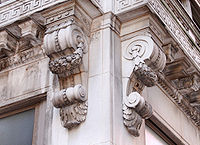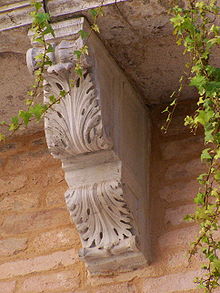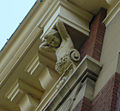- Corbel
-
For other uses, see Corbel (disambiguation).
 Elaborately decorated classical-style stone corbels support balconies on a building in Indianapolis.
Elaborately decorated classical-style stone corbels support balconies on a building in Indianapolis.
 Corbel of the Troyes Cathedral.
Corbel of the Troyes Cathedral.
In architecture a corbel (or console) is a piece of stone jutting out of a wall to carry any superincumbent weight. A piece of timber projecting in the same way was called a "tassel" or a "bragger".[1] The technique of corbelling, where rows of corbels deeply keyed inside a wall support a projecting wall or parapet, has been used since Neolithic times.[2] It is common in Medieval architecture and in the Scottish baronial style as well as in the Classical architectural vocabulary, such as the modillions of a Corinthian cornice and in ancient Chinese architecture.
The word "corbel" comes from Old French and derives from the Latin corbellus, a diminutive of corvus (a raven) which refers to the beak-like appearance.[1] Similarly, the French refer to a bracket-corbel, usually a load-bearing internal feature, as corbeau (a crow). A cul-de-lampe is a kind of bracket-corbel supporting a vault; the term is also used for a corbel with a tapering base.[3] Italians use mensola ("little table"), the Germans Kragstein ("collar stone").[1] The usual word in modern French for a corbel in the context of Classical architecture is modillon.
In traditional Chinese architecture, such a load-bearing structural element, made of stone or wood, is called dougong and has been used since the late centuries BC.
Contents
Decorated corbels
Norman (Romanesque) corbels often have a plain appearance,[1] although they may be elaborately carved with stylised heads of humans, animals or imaginary "beasts", and sometimes with other motifs (Kilpeck church in Herefordshire is a notable example, with 85 of its original 91 richly carved corbels still surviving).[4]
Similarly, in the Early English period, corbels were sometimes elaborately carved, as at Lincoln Cathedral, and sometimes more simply so.[1]
Corbels sometimes end with a point apparently growing into the wall, or forming a knot, and often are supported by angels and other figures. In the later periods the carved foliage and other ornaments used on corbels resemble those used in the capitals of columns.[1]
Throughout England, in half-timber work, wooden corbels ("tassels" or "braggers") abound, carrying window-sills or oriel windows in wood, which also are often carved.[1]
In Classical architecture
The corbels carrying balconies in Italy and France were sometimes of great size and richly carved, and some of the finest examples of the Italian "Cinquecento" (16th century) style are found in them. Taking a cue from 16th-century practice, the Paris-trained designers of 19th-century Beaux-Arts architecture were encouraged to show imagination in varying corbels.[citation needed]
Corbel tables
A corbel table is a projecting moulded string course supported by a range of corbels. Sometimes these corbels carry a small arcade under the string course, the arches of which are pointed and trefoiled. As a rule the corbel table carries the gutter, but in Lombard work the arcaded corbel table was utilized as a decoration to subdivide the storeys and break up the wall surface. In Italy sometimes over the corbels will form a moulding, and above a plain piece of projecting wall forming a parapet.[1]
The corbels carrying the arches of the corbel tables in Italy and France were often elaborately moulded, and sometimes in two or three courses projecting over one another; those carrying the machicolations of English and French castles had four courses.[citation needed]
In modern chimney construction a corbel table is constructed on the inside of a flue in the form of a concrete ring beam supported by a range of corbels. The corbels can be either in-situ or pre-cast concrete. The corbel tables described here are built at approximately ten metre intervals to ensure stability of the barrel of refractory bricks constructed thereon.[citation needed]
Corbelling
Main article: Corbel archCorbelling, where rows of corbels gradually build a wall out from the vertical, has long been used as a simple kind of vaulting, for example in many Neolithic chambered cairns where walls are gradually corbelled in until the opening can be spanned by a slab.
In medieval architecture the technique was used to support upper storeys or a parapet projecting forward from the wall plane, often to form machicolation where openings between corbels could be used to drop things onto attackers. This later became a decorative feature, without the openings. Corbelling supporting upper stories and particularly supporting projecting corner turrets subsequently became a characteristic of the Scottish baronial style.
Medieval timber-framed buildings often employ jettying, where upper stories are cantilevered out on projecting wooden beams in a similar manner to corbelling.
Gallery
-
Gallarus Oratory, an early Christian church in Ireland, built with corbel vaulting
-
Norman corbel at Kilpeck, England, showing a hound and hare, 12th century
-
Stone corbel at Boyle Abbey, 13th century
-
Corbelling supporting parapets with machicolations at Montmajour Abbey, France (14th century)
-
Corbelling supporting corner turrets at Newark Castle, Port Glasgow on a Renaissance mansion of c.1600
-
Craigievar Castle, Scotland (completed 1626), displays corbelling supporting upper storeys, corner turrets and stairwells projecting out from the wall line
-
A corbel in Paris (with a lion mask and oakleaves forming its cul-de-lampe)
-
Carved stone corbel from the monastic cellars at West Langdon Abbey, Kent.
-
19th century Italianate houses with corbel brackets under the eaves in Covington, Kentucky
-
Corbel on a 1907 commercial building in Saskatoon, Canada
-
Gothic corbel at Walcourt, Belgium, 16th century
Examples
- Maes Howe, a particularly fine Neolithic chambered cairn in Scotland.
See also
Notes
- ^ a b c d e f g h
 Chisholm, Hugh, ed (1911). "Corbel". Encyclopædia Britannica (11th ed.). Cambridge University Press.
Chisholm, Hugh, ed (1911). "Corbel". Encyclopædia Britannica (11th ed.). Cambridge University Press. - ^ See for example, Maes Howe, a particularly fine Neolithic chambered cairn in Scotland.
- ^ Die.net definition
- ^ CRSBI website: St Mary and St David, Kilpeck, Herefordshire
References
 Chisholm, Hugh, ed (1911). "Corbel". Encyclopædia Britannica (11th ed.). Cambridge University Press.
Chisholm, Hugh, ed (1911). "Corbel". Encyclopædia Britannica (11th ed.). Cambridge University Press.- The CRSBI (Corpus of ROMANESQUE SCULPTURE in Britain and Ireland) website has many examples of carved Norman corbels
- Curl, James Stevens (2006) (Paperback). A Dictionary of Architecture and Landscape Architecture (Second ed.). Oxford University Press. pp. 880 pages. ISBN 0-19-860678-8.
External links
- Beyond-the-pale A discursive and richly-illustrated website showing corbels on hundreds of churches in the British Isles, France and Spain, depicting the sins of the flesh and their punishment
- An illustrated glossary of the terms used masonry construction.
Categories:- Architectural elements
- Ornaments
- Garden features
- Medieval defences
- Corbels
- Scottish baronial architecture
-
Wikimedia Foundation. 2010.

















